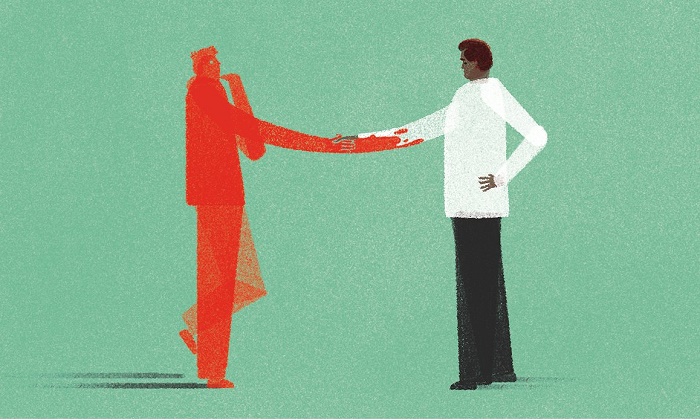(On the flipside, researchers have found that college students obliged to share rooms with depressed classmates are at heightened risk of “catching” their thinking styles.) And it’s been shown that merely seeing someone acting stressed, even a stranger, can elevate your own levels of cortisol. From an evolutionary point of view, this isn’t surprising. After all, if a person in your visual field is making faces as if a marauding tribe is about to attack you from behind, that’s probably because they are – in which case, being suddenly on edge could save your life. These days, when marauding tribes usually aren’t an imminent risk, anxiety isn’t much use. Sadly, it remains contagious.
“Anxiety is conductive,” argues the designer Mike Monteiro, in an old essay that got a new surge of online attention a few weeks ago. “It wants to travel from one person to another person.” At his design studio, they have a rule: Stop Adopting Other People’s Anxiety. “Once a client becomes anxious,” Monteiro writes, “their primary goal becomes to make you anxious, because that justifies their own anxiety.”
The other major hazard when it comes to worry and anxiety is that, unlike other negative emotions, they seem productive; chewing over a problem feels like doing something about it. And so we’d like others to share our worry: that way, several people will be “working” on the problem. The hitch, of course, is that worry isn’t really productive: usually, it’s a distraction, and leads to lower-quality work. Alan Watts made a version of this point back in 1951: ironically, what causes our feelings of insecurity is the desperate quest to feel secure. Worrying is the practice of trying to reach a state of serenity by engaging in precisely the activity that guarantees you’ll never get there. So you’re hardly helping an anxious person by joining them in this self-defeating spiral.
“Imagine slicing your finger open cutting a bagel,” Monteiro writes. “You freak out. You wrap it all up. You go to the emergency room. Do you want your doctor to scream when she sees it, or to look at it and very calmly say, ‘Let’s take care of that’?” This echoes the argument made by Paul Bloom, a Yale psychologist, in his book Against Empathy, out in the UK next month. Feeling others’ pain sounds like the compassionate thing to do, but it’s frequently counterproductive. (It can also lead to bad decision-making, Bloom argues: for instance, it’s easier to empathise with people who look like us, so we end up empathising in racist ways.) The truly compassionate thing, Monteiro says, is to “be the calm doctor”, which helps to keep your own worry levels in check, too.
There’s enough in the world to freak out about. No need to go sniffing around for more.
More about:
















































